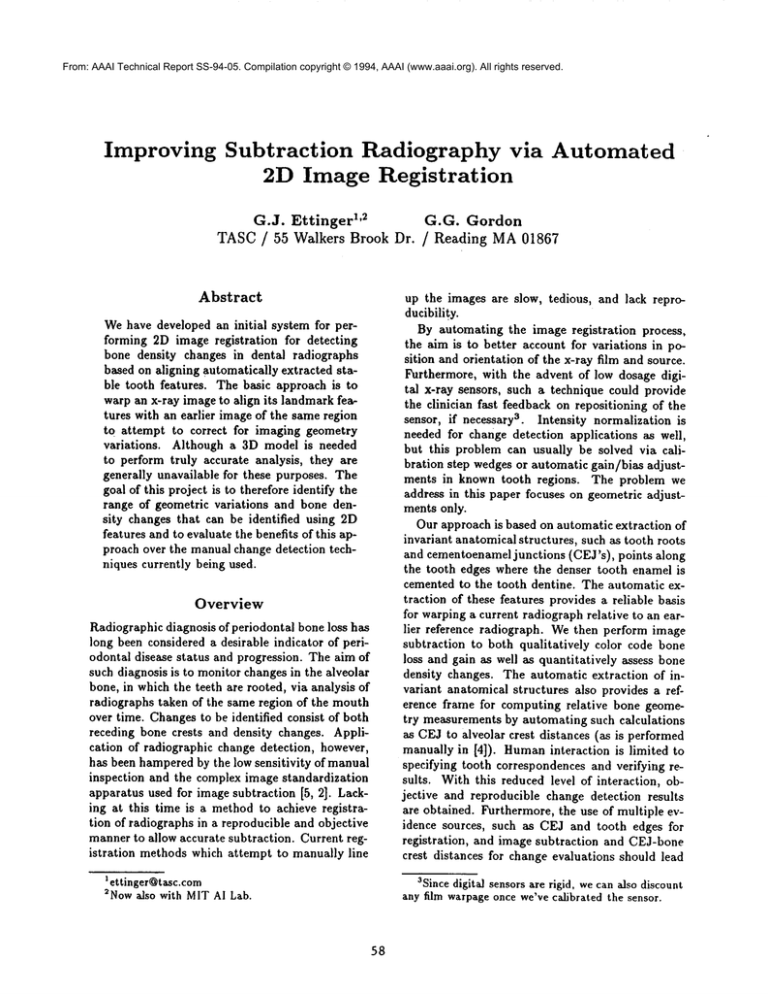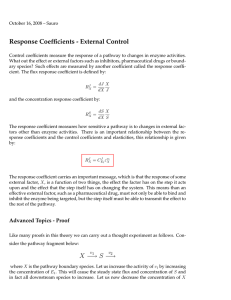
From: AAAI Technical Report SS-94-05. Compilation copyright © 1994, AAAI (www.aaai.org). All rights reserved.
Improving
Subtraction
Radiography
2D Image Registration
via
Automated
G.J. Ettinger 1’~
G.G. Gordon
TASC/ 55 Walkers Brook Dr. / Reading MA01867
Abstract
Wehave developed aa initial system for performing 2D image registration
for detecting
bone density changes in dental radiographs
based on aligning automatically extracted stable tooth features. The basic approach is to
warp an x-ray image to align its landmark features with an earlier image of the same region
to attempt to correct for imaging geometry
variations.
Although a 3D model is needed
to perform truly accurate analysis, they are
generally unavailable for these purposes. The
goal of this project is to therefore identify the
range of geometric variations and bone density changes that can be identified using 2D
features and to evaluate the benefits of this approach over the manual change detection techniques currently being used.
Overview
Radiographic diagnosis of periodontal bone loss has
long been considered a desirable indicator of periodontal disease status and progression. The aim of
such diagnosis is to monitor changes in the alveolar
bone, in which the teeth are rooted, via analysis of
radiographs taken of the same region of the mouth
over time. Changes to be identified consist of both
receding bone crests and density changes. Application of radiographic change detection, however,
has been hampered by the low sensitivity of manual
inspection and the complex image standardization
apparatus used for image subtraction [5, 2]. Lacking at this time is a method to achieve registration of radiographs in a reproducible and objective
manner to allow accurate subtraction. Current registration methods which attempt to manually line
I ettinger@tasc.com
~Nowalso with MITAI Lab.
up the images are slow, tedious, and lack reproducibility.
By automating the image registration
process,
the aim is to better account for variations in position and orientation of the x-ray film and source.
Furthermore, with the advent of low dosage digital x-ray sensors, such a technique could provide
the clinician fast feedback on repositioning of the
sensor, ff necessary a. Intensity normalization is
needed for change detection applications as well,
but this problem can usually be solved via calibration step wedges or automatic gain/bias adjustments in known tooth regions. The problem we
address in this paper focuses on geometric adjustments only.
Our approach is based on automatic extraction of
invariant anatomical structures, such as tooth roots
and cementoenamel junctions (CEJ’s), points along
the tooth edges where the denser tooth enamel is
cemented to the tooth dentine. The automatic extraction of these features provides a reliable basis
for warping a current radiograph relative to an earlier reference radiograph. Wethen perform image
subtraction to both qualitatively color code bone
loss and gain as well as quantitatively assess bone
density changes. The automatic extraction of invariant anatomical structures also provides a reference frame for computing relative bone geometry measurements by automating such calculations
aa CEJ to alveolar crest distances (as is performed
manually in [4]). Humaninteraction is limited to
specifying tooth correspondences and verifying results. With this reduced level of interaction, objective and reproducible change detection results
are obtained. Furthermore, the use of multiple evidence sources, such as CEJ and tooth edges for
registration,
and image subtraction and CEJ-bone
crest distances for change evaluations should lead
SSincedigitM sensors are rigid, we can also discount
any film warpageonce we’ve calibrated the sensor.
58
Figure 1: 2Dregistration and changedetection system.
to more reliable results.
Technical
Approach
Since we do not have 3D models available for this
task, we make several simplifying assumptions:
¯ Teeth can be approximated as cylinders so minireal geometrical shape variations are introduced
on the vertical edges of the teeth for small viewpoint variations.
¯ The registration is based on invariant point features on the teeth, preferably on both sides of the
bone crest region, such as CEJ’s and root tips.
Since these features are close to the vertical bisecting plane of the teeth, the locations of these
point features in the image will generally correspond to the same physical location on the teeth
under the expected ranges of viewing variations.
¯ Using orthographic projection, the viewing variations can be corrected via a linear transformation. Weperform a bilinear warping to also account for somedistortion in the film as well.
The system diagram for the this system is shown
in Figure 1. The processing is designed to be automatic after initial coarse manual alignment which
labels the teeth to produce tooth correspondences.
Weused a Canny edge detector [1] for extracting
tooth and bone edge points, which are linked together based on their proximity. Small gaps are
filled by interpolation. CEJ extraction is then performed by matching a CEJ model along identified
vertical tooth edges. The CEJ model represents the
59
two neighboring enamel and dentine regions via A’s
in the means and standard deviations of the regions
as well as the angle between the interface boundary
and the tooth edge. The extracted CEJ’s and tooth
boundaries are then Used to align the two images.
Given the initial coarse manual image alignment,
we use the edge contour gradient direction to match
corresponding CEJ’s and tooth edges from the two
images. Based on the point correspondences we
compute the least-squares bilinear warping coefficients and warp one of the images relative to the
other. It is at this point that decisions could be
made on whether the desired warping is too drastic, thus requiring user verification or re-imaging.
Bone gain/loss and density change assessment can
then made by subtracting the two images and measuring changes in the CEJ-alveolar crest distances.
Wehave currently implemented edge detection,
contour tracking, preliminary CEJ extraction, bilinear image warping, and image subtraction modules [3].
Results
As a test case we used radiographs taken of a patient treated by Widmanflap surgery, made available to us by the Forsyth Dental Center, Boston
MA.The first radiograph was taken prior to surgery
and the second taken six months after surgery.
These were film radiographs which we digitized at
600 dpi on a ColorGetter+ drum scanner 4. A corresponding image pair from this patient is shownin
the top of Figure 2. Note that although manual efforts were taken to geometrically standardize these
images, the configuration of overlapping teeth differs in the two images indicating the need for some
warping to accurately register the two images.
Preliminary results of automatic extraction of
CEJ’s are shown in the lower left of Figure 2.
Candidate CEJ’s are shown as white circles. The
brightness of the original images has been decreased
to make the dots apparent. These preliminary tests
indicate that accurate automated localization of
CEJ’s is feasible with these images. Although several false candidate CEJ locations were generated,
they could be removed from consideration based
on knowledge of general teeth location. Although
desirable, not all CEJ points are necessary for performing the image registration. Rather, we need to
have sufficient coverage of alignment points across
both images.
As an example of how the extracted CEJ points
can be used, we identified the correspondences of
4Optronics, a Division of Intergraph, Chelmsford
MA
, .:..,
’ .;..’
’,
;" , ¯,..,i.,"
.
., .,, :;,. ;¯" ,
..., ~.-,
.
ii:i::ii:~
:::L: :~:
:i,i:~
i:::ii:
:/¯....
¯ :~i~iq~::i:i
"~: "’:i"’.
"
~.
. ¯ . ..
. :... -, .
¯ ,,¯: ¯ .’:.~.
.¯: Z:.,. .11¯!::.-
Figure 2: Original reference radiograph(top left) and correspondingradiographtaken six monthslater (top right).
CandidateCEJ’sextracted in secondradiograph(bottomleft) andresulting changesafter warping(bottomright).
6O
the automatically extracted CEJ’s as a basis for
aligning and warping one the images relative to the
other. In lieu of tooth root tips, we manually specified additional correspondence points to achieve
adequate coverage of alignment points across the
images.
Areas of significant change were then highlighted
in the subtracted image to indicate bone loss and
gain. These results are shownin the bottom right of
Figure 2 where bone loss is shownin black and gain
in white overlaid on the reduced contrast original
radiograph. By visual comparison with the original
radiographic images, it can be noted that these results highlight areas of apparent bone regeneration
and increased bone density in several interproximal regions. On first inspection of the radiographs
it may have not been clear whether the changes are
due to bone gain or loss. In this particular case,
little bone loss is evident.
Conclusion
The need for accurate and reproducible alveolar
bone change detection suggests a reliable automated procedure for accomplishing this task. We
are exploring a promising approach based on invariant anatomical structures that overcome some
of the problems in performing subtraction radiography caused by viewing geometry variations. Further studies are necessary to determine the levels
of reproducibility and sensitivity of this approach.
References
[1] J.F. Canny, ~A Computational Approach to Edge
Detection," IEEETransactions of Pattern Analysis and MachineIntelligence, PAMI-8(6),1986.
[2] J.E. Duckworth, P.F. Judy, J.M. Goodson, S.S.
Socransky, "A Methodfor Geometric and Densitometric Standardization of Intraoral Radiographs,"
.lournal of Periodontoiogy,12, 1983.
[3] G.J. Ettinger, G.G. Gordon, J.M. Goodson, S.S.
Socransky, R. Williams, "Developmentof Automated Registration Algorithms for Subtraction
Radiography,"to appear in Journal of Clinical Periodontology,8, 1994.
[4] E. Hansmann,K. Allen, R. Dunford, L. Christersson, "A Reliable Computerized Methodto Determine the Level of Radiographic Alveolar Crest",
Journal of Periodontal Research,24, 1989.
[5] M.K. Jeffcoat, M.S. Reddy, R.L. Webber, R.C.
Williams, U.E. Ruttiman, "Extraoral Control of
Geometryfor Digital Subtraction Radiography,"
Journal of Periodontal Research,22, 1987.
61




